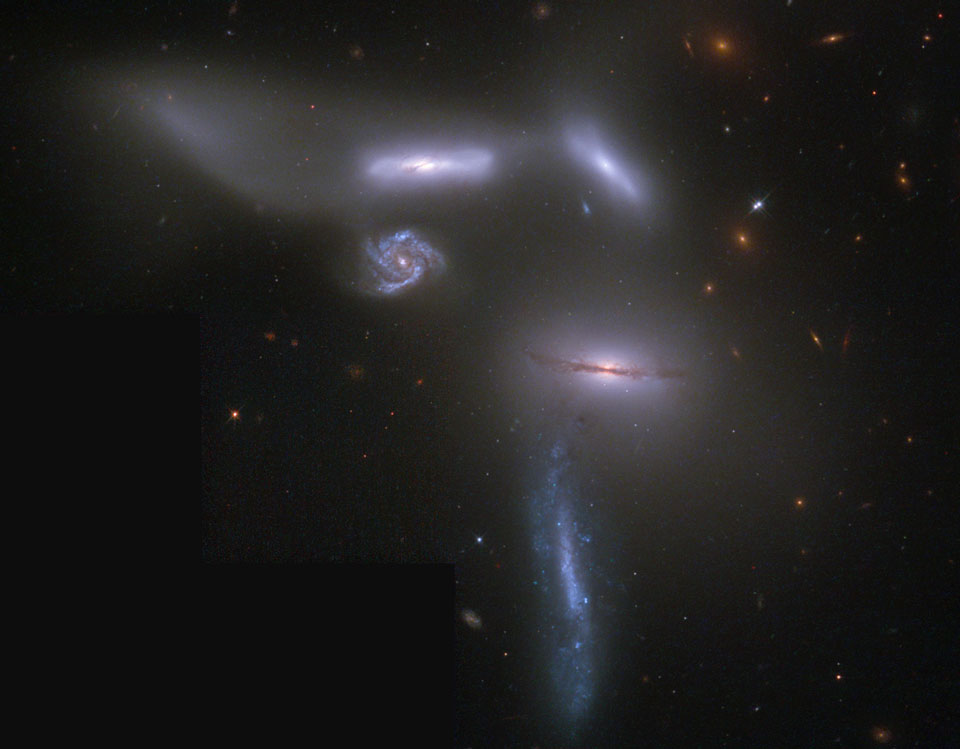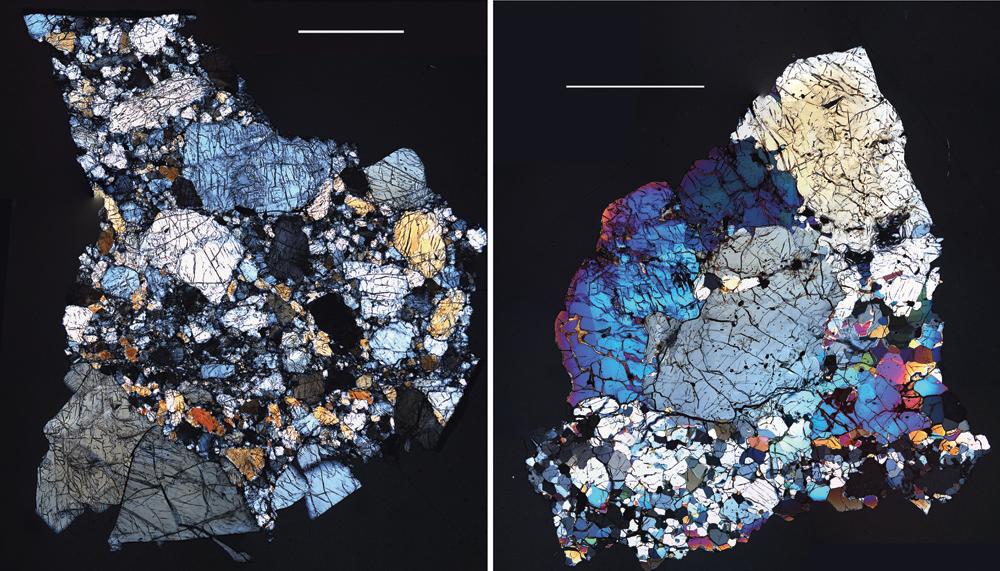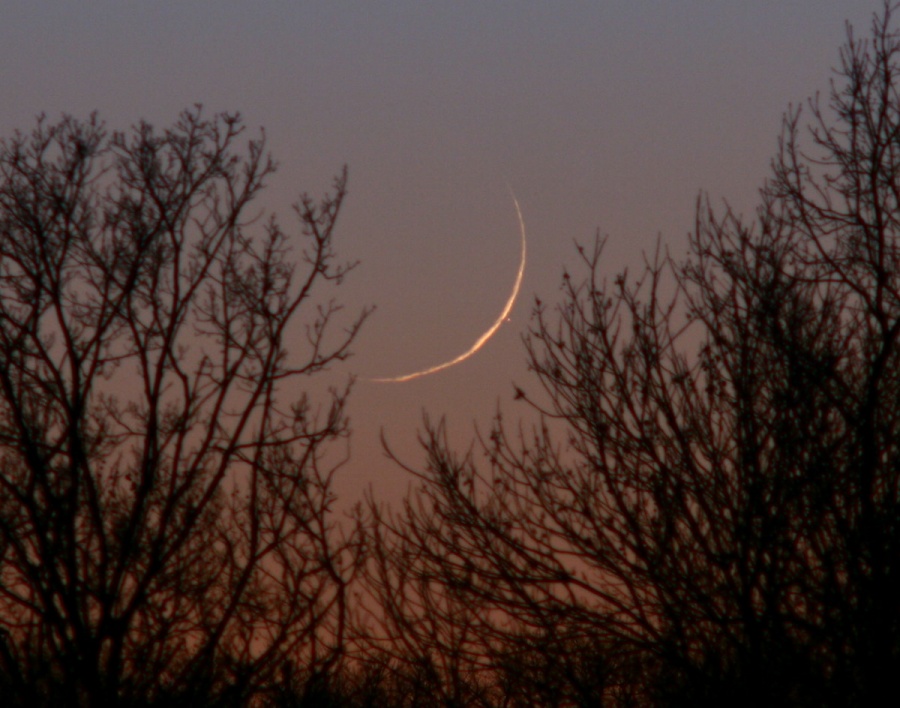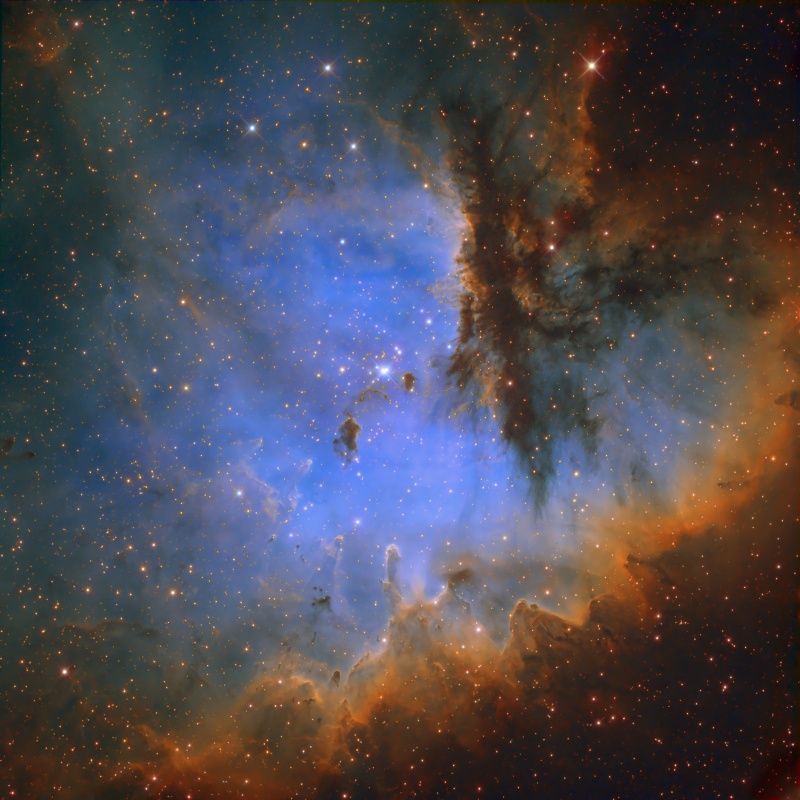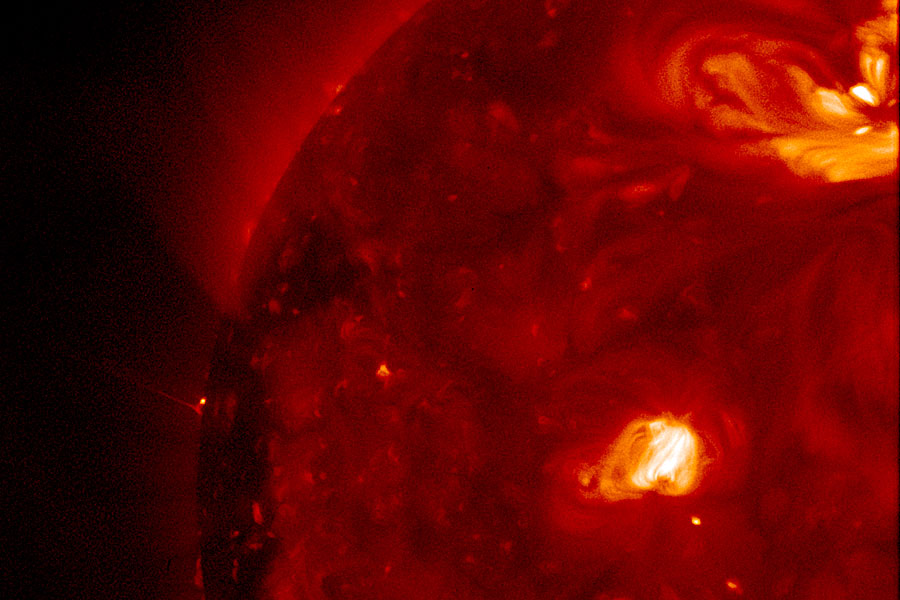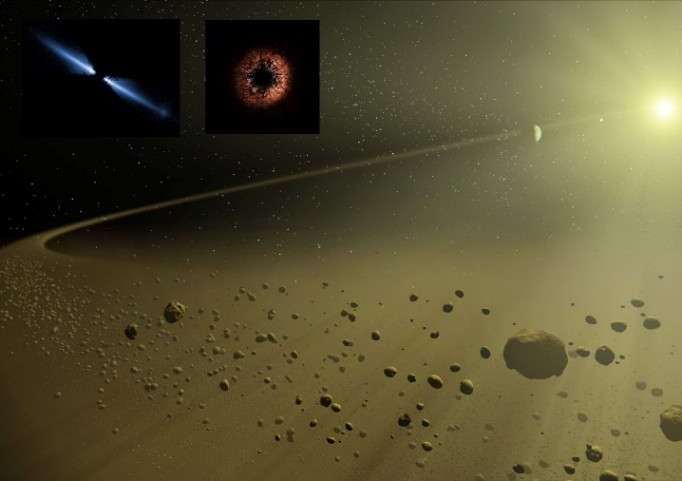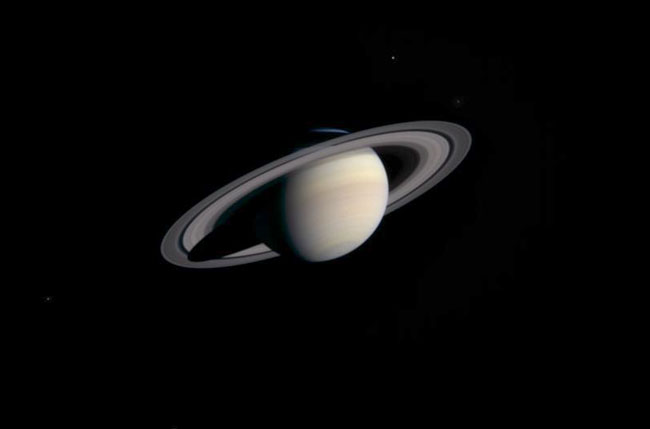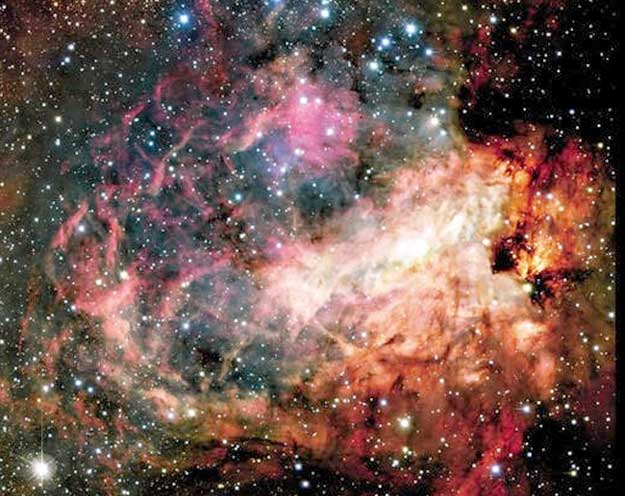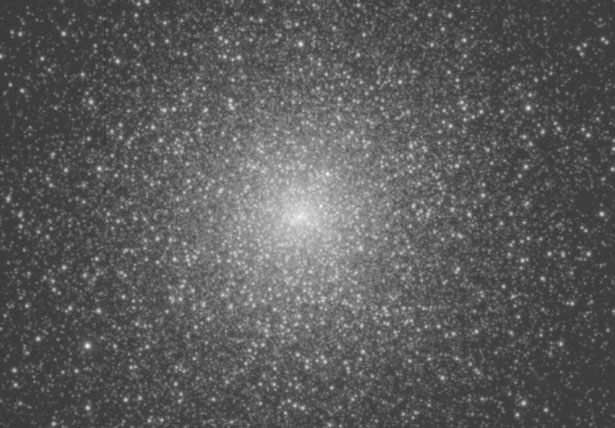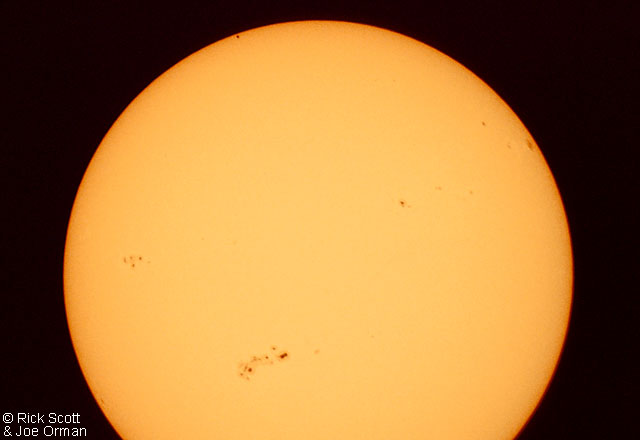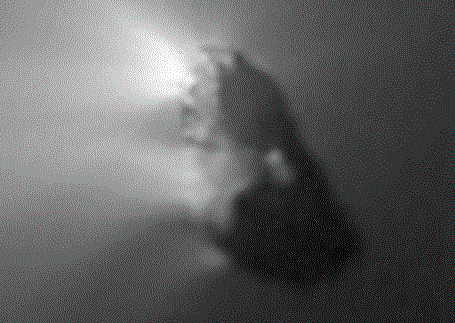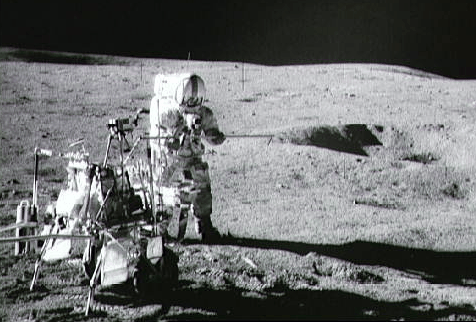| << Previous | Index | Next >> |
2014
[imghover6=http://apod.nasa.gov/apod/image/1412/m71Franke.jpg]http://apod.nasa.gov/apod/image/1412/m71FrankeNoExt.jpg[/imghover6]Image Credit & Copyright: Bob Franke
2013 What will survive this battle of the galaxies? Known as Seyfert's Sextet, this intriguing group of galaxies lies in the head portion of the split constellation of the Snake (Serpens). The sextet actually contains only four interacting galaxies, though. Near the center of this Hubble Space Telescope picture, the small face-on spiral galaxy lies in the distant background and appears only by chance aligned with the main group. Also, the prominent condensation on the upper left is likely not a separate galaxy at all, but a tidal tail of stars flung out by the galaxies' gravitational interactions. About 190 million light-years away, the interacting galaxies are tightly packed into a region around 100,000 light-years across, comparable to the size of our own Milky Way galaxy, making this one of the densest known galaxy groups. Bound by gravity, the close-knit group may coalesce into a single large galaxy over the next few billion years.
2012
Video Credit & Copyright: Colin Legg
2011
2010 A thin, one day old crescent Moon hugged the western horizon after sunset on Monday, December 6. The Moon also occulted or passed in front of Mars. But only some well-placed skygazers along a band through North America were able to catch this lunar occultation's final act in fading twilight. For example, this telephoto image nicely captures Mars as a pinprick of light, shortly after it emerged from behind the crescent Moon's sunlit edge. With a tangle of tree limbs in silhouette, the luminous skyview is from De Soto, Kansas in the central US. Of course, this month's upcoming total lunar eclipse will entertain a much wider audience of Moon enthusiasts during the night of December 20/21.
2009 This colorful cosmic portrait features glowing gas and obscuring dust clouds in IC 1795, a star forming region in the northern constellation Cassiopeia. The nebula's colors were created by adopting the Hubble false-color palette for mapping narrow emission from oxygen, hydrogen, and sulfur atoms to blue, green and red colors, and further blending the data with images of the region recorded through broadband filters. Not far on the sky from the famous Double Star Cluster in Perseus, IC 1795 is itself located next to IC 1805, the Heart Nebula, as part of a complex of star forming regions that lie at the edge of a large molecular cloud. Located just over 6,000 light-years away, the larger star forming complex sprawls along the Perseus spiral arm of our Milky Way Galaxy. At that distance, this picture would span about 70 light-years across IC 1795.
2008 Look through the cosmic cloud cataloged as NGC 281 and it's almost easy to miss stars of open cluster IC 1590. But, formed within the nebula, that cluster's young, massive stars ultimately power the pervasive nebular glow. The eye-catching shapes looming in this colorful portrait of NGC 281 are sculpted columns and dense dust globules seen in silhouette, eroded by intense, energetic winds and radiation from the hot cluster stars. If they survive long enough, the dusty structures could also be sites of future star formation. Sometimes called the Pacman Nebula because of its overall shape in wider-field views, NGC 281 is about 10,000 light-years away in the constellation Cassiopeia. This composite image was made through narrow-band filters and shows emission from the nebula's hydrogen, sulfur, and oxygen atoms in green, red, and blue hues. It spans over 80 light-years at the estimated distance of NGC 281.
2007 What powers the solar wind? Our Sun is known to emit a powerful wind of particles with gusts that can even affect astronauts and satellites orbiting Earth. The cause of the solar wind has been debated for decades but is thought to be rooted in Alfvén waves generated by the ever changing magnetic field of the Sun. Newly released images from the Japanese Hinode satellite appear to bolster this hypothesis, imaging an average of 240 daily plasma jets that are excellent candidates to fuel the outwardly moving Alfvén waves. The jets and waves are themselves ultimately created by magnetic reconnection events, rapid events where lines of constant magnetic field suddenly move extremely rapidly, dragging electrons and protons along with them. On the image left, one such jet is visible in X-ray light. Bright spots show relatively energetic regions elsewhere on the Sun.
2006 What would it be like to explore the surface of another world? In 1972 during the Apollo 17 mission, astronaut Harrison Schmitt found out first hand. In this case, the world was Earth's own Moon. In this recently compiled panorama of lunar photographs originally taken by astronaut Eugene Cernan, the magnificent desolation of the barren Moon is apparent. Visible above and by scrolling right are lunar rocks in the foreground, lunar mountains in the background, some small craters, a lunar rover, and astronaut Schmidt on his way back to the rover. A few days after this image was taken, humanity left the Moon and has yet to return.
2005 In 1865 Jules Verne predicted the invention of a space capsule that could carry people. His science fiction story "From the Earth to the Moon" outlined his vision of a cannon in Florida so powerful that it could shoot a Projectile-Vehicle carrying three adventurers to the Moon. Over 100 years later NASA, guided by Wernher Von Braun's vision, produced the Saturn V rocket. From a spaceport in Florida, this rocket turned Verne's fiction into fact, launching 9 Apollo Lunar missions and allowing 12 astronauts to walk on the Moon. As spotlights play on the rocket and launch pad at dusk, the last moon shot, Apollo 17, is pictured here awaiting its December 1972 night launch.
2004 In this dramatic artist's vision, debris along the outer reaches of a planet forming disk orbits in the glare of a distant sun. But inset are actual images of such disks around two nearby stars - AU Microscopii (top left; edge-on) and HD107146 (right: face-on) - as seen by the Hubble Space Telescope. Combined with infrared images from the Spitzer Space Telescope that show debris disks around known planet bearing stars, the data provide the first direct link between extrasolar disks and planets, suggesting a scenario where evolving planets scatter debris produced by collisions into giant disks. In time, the dusty disks may dwindle and become like our own Solar System's comet reservoir, the Kuiper Belt.
2003 Cassini, a robot spacecraft launched in 1997 by NASA, is close enough now to resolve many rings and moons of its destination planet: Saturn. The spacecraft has now closed to within a single Earth-Sun separation from the ringed giant. Early last month, Cassini snapped the contrast-enhanced color composite pictured above. Many features of Saturn's rings and cloud-tops now show considerable detail. When arriving at Saturn in July 2004, the Cassini orbiter will begin to circle and study the Saturnian system. Several months later, a probe named Huygens will separate and attempt to land on the surface of Titan.
2002 In the depths of the dark clouds of dust and molecular gas known as M17, stars continue to form. The similarity to the Greek letter capital Omega gives the molecular cloud its popular name, but the nebula is also known as the Swan Nebula, the Horseshoe Nebula, and M17. The darkness of these molecular clouds results from background starlight being absorbed by thick carbon-based smoke-sized dust. As bright massive stars form, they produce intense and energetic light that slowly boils away the dark shroud. M17, pictured above, is visible with binoculars towards the constellation of Sagittarius, lies 5000 light-years away, and spans 20 light-years across.
2001 Stars, like bees, swarm around the center of bright globular cluster M15. This ball of over 100,000 stars is a relic from the early years of our Galaxy, and continues to orbit the Milky Way's center. M15, one of about 150 globular clusters remaining, is noted for being easily visible with only binoculars, having at its center one of the densest concentrations of stars known, and containing a high abundance of unusual variable stars and pulsars. The above image, taken in ultraviolet light with the WIYN Telescope, spans about 120 light years and shows the gradual increase in stars toward the cluster's center. M15 lies about 35,000 light years away toward the constellation of Pegasus. Recent evidence indicates that a massive black hole might reside as the center of M15.
2000 What would you see if you went right up to a black hole? Above are two computer generated images highlighting how strange things would look. On the left is a normal star field containing the constellation Orion. Notice the three stars of nearly equal brightness that make up Orion's Belt. On the right is the same star field but this time with a black hole superposed in the center of the frame. The black hole has such strong gravity that light is noticeably bent towards it - causing some very unusual visual distortions. In the distorted frame, every star in the normal frame has at least two bright images - one on each side of the black hole. In fact, near the black hole, you can see the whole sky - light from every direction is bent around and comes back to you. Black holes are thought to be the densest state of matter, and there is indirect evidence for their presence in stellar binary systems and the centers of globular clusters, galaxies, and quasars.
1999 OK, it's a picture of the Sun (duh!), but can you spot the planet? Of course, most of the spots you've spotted are sunspots, as large or larger than planet Earth itself. The sunspots are regions of strong surface magnetic fields which are dark in this picture only because they are relatively cool compared to their surroundings. Over the past few years, the number of sunspots has been steadily increasing as the Sun approaches the maximum in its 11 year activity cycle. But also visible in this photograph from November 15, is planet Mercury. At just over 1/3 Earth's size, Mercury is passing in front of the Sun, its silhouette briefly creating a diminutive dark spot drifting across an enormous solar disk. While "transits" of Mercury do occur 13 times a century, this one was additionally a very rare grazing transit of our Solar System's innermost planet. Spotted Mercury yet? Click on the picture for a hint.
1998 Batteries and solar panels were included with this version of the International Space Station (ISS) but some assembly is still required. On Saturday, December 5th, the STS-88 crew of the Space Shuttle Endeavor achieved the in orbit docking of the Zarya and Unity (foreground) ISS modules. On Monday, astronauts James Newman (left) and Jerry Ross continued the assembly procedures connecting power and data cables during the first of three planned spacewalks. Ground controllers were then able to successfully activate the ISS. Now orbiting planet Earth at an altitude of about 248 miles, Endeavour and the ISS are reported to be in excellent shape and crew members plan to enter the new space station today. Five Americans, one Russian, and the Unity module itself were lifted into orbit by the shuttle on Friday, December 4, while the Zarya (sunrise) module was launched on a Proton rocket from the Baikonur Cosmodrome in Kazakstan on November 20.
1997 Yes, but can your soccer ball do this? The ball near the middle of the above photograph is actually a robotic camera designed to float about a Space Shuttle and the International Space Station and take pictures. Named "Sprint", it is NASA's first Autonomous Extravehicular Activity Robotic Camera (AERCam) and was tested earlier this month by the crew of Space Shuttle Columbia. Sprint's diameter is actually about 50 percent larger than a soccer ball, and astronauts make a goal of not kicking it.
1996 Here is what a comet nucleus really looks like. For all active comets except Halley, it was only possible to see the surrounding opaque gas cloud called the coma. During Comet Halley's most recent pass through the inner Solar System in 1986, however, spacecraft Giotto was able to go right up to the comet and photograph its nucleus. The above image is a composite of hundreds of these photographs. Although the most famous comet, Halley achieved in 1986 only 1/10th the brightness that Comet Hyakutake did last year, and a similar comparison is likely with next year's pass of Comet Hale-Bopp. Every 76 years Comet Halley comes around again, and each time the nucleus sheds about 6 meters of ice and rock into space. This debris composes Halley's tails and leaves an orbiting trail that, when falling to Earth, are called the Orionids Meteor Shower.
1995 After the lunar module of Apollo 14 set down on the Moon, Astronauts Alan Shepard and Edgar Mitchell deployed the Apollo Lunar Surface Experiments Package (ALSEP) and collected samples of lunar material. The ALSEP scientific experiments included a seismometer sensitive to slight lunar surface movements, and charged particle detectors which measured the solar wind. The seismometer successfully measured surface tremors interpreted as moonquakes and meteoroids striking the Moon, while the solar wind experiment was sensitive enough to detect the element argon. These and other ALSEP experiments helped classify the internal structure and magnetic field of Earth's Moon. Shepard and Mitchell also made a geology traverse to the rim of Cone Crater, carrying their tools and sample containers in the Modular Equipment Transporter (MET). In this picture Alan Shepard assembles a core tube which he will then hammer into the surface.
| << Previous | Index | Next >> |
